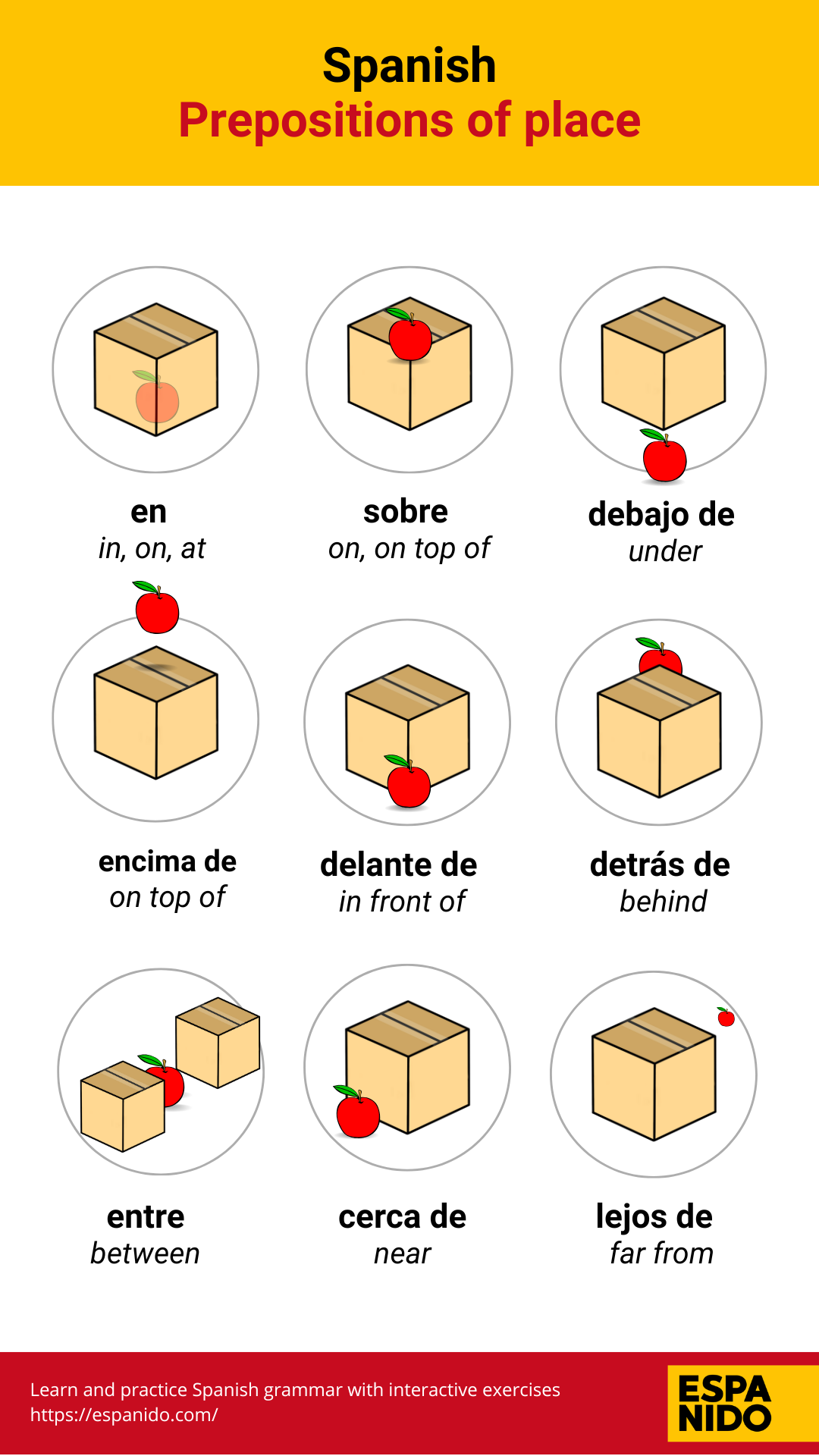Prepositions in Spanish.List of Most Common Spanish Prepositions.
What are Spanish Prepositions?
A preposition is a word that shows the relationship between nouns, pronouns, and other words in a sentence. In Spanish, prepositions connect words and indicate relationships of time, place, direction, and more.
Most Common Spanish Prepositions
-
a - to, at
Voy a la tienda (I’m going to the store) -
ante – before, in front of
Hablé ante el público (I spoke before the audience) -
bajo – under, below
El gato está bajo la mesa (The cat is under the table) -
con – with
Voy con mi amigo (I’m going with my friend) -
contra – against
Estoy contra la pared (I’m against the wall) -
de – of, from
El libro de Juan (Juan’s book) -
desde – from, since
Trabajo desde las ocho (I work from eight) -
durante – during
Durante la película (During the movie) -
en – in, on
Estoy en casa (I’m at home) -
entre – between
Entre tú y yo (Between you and me) -
hacia – toward
Camina hacia la puerta (Walk toward the door) -
hasta – until, up to
Trabajaré hasta las cinco (I’ll work until five) -
para – for, in order to
Este regalo es para ti (This gift is for you) -
por – for, by, through
Gracias por tu ayuda (Thanks for your help) -
según – according to
Según el profesor (According to the professor) -
sin – without
Café sin azúcar (Coffee without sugar) -
sobre – on, about
El libro está sobre la mesa (The book is on the table) -
tras – after, behind
Tras la puerta (Behind the door)
Prepositions of Place in Spanish
These prepositions describe where something is located.

-
en - in, on, at
La pluma está en la mesa -
sobre – on top of
El libro está sobre el escritorio -
debajo de – under
El gato está debajo de la cama -
encima de – on top of
Hay una lámpara encima de la mesa -
detrás de – behind
El jardín está detrás de la casa -
delante de – in front of
Hay un árbol delante de mi ventana -
entre – between
El banco está entre la tienda y el restaurante - cerca de – near
Vivo cerca del parque -
lejos de – far from
La playa está lejos de aquí
Prepositions of Time and Manner
Time:
-
a - at (specific times)
La reunión es a las tres - de – from
Trabajamos de nueve a cinco -
desde – since
Estoy esperando desde las dos -
hasta – until
Estaré aquí hasta las seis -
durante – during
Durante el verano, voy a la playa - en – in (months, years)
Nací en mayo
Manner:
- con – with
Escribo con un lápiz -
sin – without
Prefiero el café sin azúcar - por – by
Enviamos la carta por correo
How to Use "De", "En", and "A" Correctly
De
- Possession: El libro de María
- Origin: Soy de México
- Material: Una mesa de madera
- Contents: Una taza de café
- Time: Son las diez de la noche
En
- Location: Estoy en casa
- Time: En verano hace calor
- Transportation: Viajo en tren
- State: Está en buena forma
A
- Direction: Voy a la tienda
- Time: Llegamos a las ocho
- Indirect objects: Le di el libro a Juan
- Personal "a": Vi a mi amigo
Common Mistakes:
- ❌ Voy en la escuela
✅ Voy a la escuela - Soy de España vs. Vengo desde España
Spanish Prepositions with Verbs
- Pensar en - Pienso en mis vacaciones
- Soñar con – Sueño con viajar por el mundo
- Hablar de – Hablamos de política
- Depender de – Dependo de mi trabajo
- Preocuparse por – Me preocupo por ti
- Contar con – Puedes contar conmigo
- Acordarse de – Me acuerdo de ti
Learning Tip: Learn prepositions in context with verbs or phrases. Try interactive exercises!
Prepositional Phrases in Spanish
-
a causa de - because of
No pude venir a causa del tráfico -
a pesar de – despite
A pesar de la lluvia, fuimos al parque -
acerca de – about
Hablamos acerca de su nuevo trabajo -
al lado de – next to
Mi casa está al lado del parque -
antes de – before
Siempre me ducho antes de desayunar -
después de – after
Después de la clase, vamos a comer -
en vez de – instead of
Tomé té en vez de café -
por medio de – by means of
Lo arreglamos por medio de negociaciones